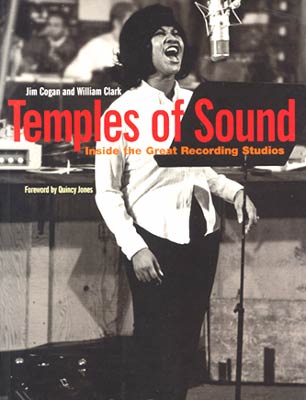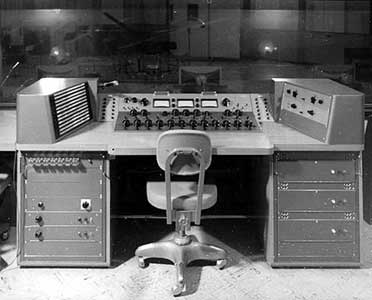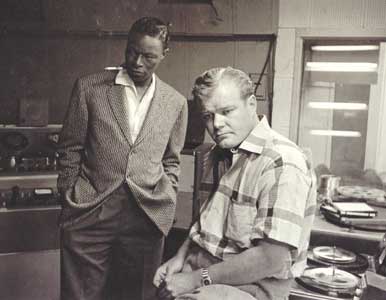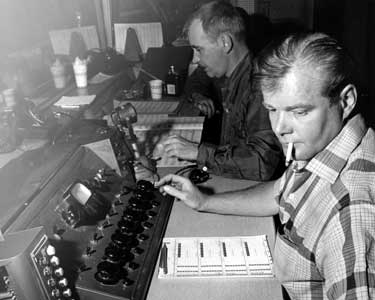Interview: Temples of Sound
Inside the Great Recording Studios By Jim Cogan and William Clark
 |
City of Angels
Since the late ’40s, the country’s premier studio musicians have migrated west to Hollywood. Whether playing on film scores, television scores, clubs, or cartoons, this is where the action, and the money, is. New York’s Brill Building, the songwriting factory where so many early-’60s hits were born, was on the wane, and the studios back east were perceived to be full of character, perhaps, but hardly state-of-the-art.
“My dad and Les Paul, who was a family friend, used to tease each other and say, ‘You were the first, No you were,’” says Putnam’s son, Bill Jr.
By the mid-’60s, L.A. was the place for pop. “You could walk down the halls at United Western and you’d hear the Beach Boys in 3, the Mamas and the Papas in 2, the Righteous Brothers [over there], Dean Martin would be in 1, it was amazing” says Allen Sides, who in 1977 would take the reins as owner of United Western, renaming the studios Ocean Way. Fresh-faced baby-booming renegades like Sam Cooke, Phil Spector, John Phillips, and Brian Wilson became the vanguard of new pop sounds.
The studios of the ’50s, lashed to labels like CBS, RCA, and Capitol, seemed somehow stodgy and stultifying to this new breed of artist. By the late ’60s, “some of those studios had become like old-folk’s homes,” says Allen Sides. Autonomy was demanded and granted on an unprecedented level. These new artistes wanted to work in the studios they wanted to work in, far from corporate glare. Both CBS and Capitol were still cutting tracks, but rarely were they cutting edge. Most of the new breed was gathering at one of three spots: Gold Star (Spector), Sunset Sound (Turtles, the Doors, Brasil ’66, Buffalo Springfield), or United Western (the rest).
How did this complex of studios start? Why are these rooms considered to be among the best sounding ever? Why have they gone virtually unchanged from their original design?
 |
|
Putnam-designed United console, Chicago 1957
|
With the exception of guitarist and recording innovator Les Paul, no one had the renaissance scope encompassing music and technology that Bill Putnam did. “My dad and Les Paul, who was a family friend, used to tease each other and say, ‘ You were the first, No you were,’” says Putnam’s son, Bill Jr.
Such “firsts” include overdubbing multiple voices onto tape, the first use of artificial reverb, the first vocal booths, the first half-speed mastering, the first use of delay lines in the studio; in short, these two men did more to bring recording and its technology into the present than practically everyone else combined. Putnam himself was a songwriter, inventor of the modern recording console, producer, mixer, studio designer, singer, and businessman proficient in the art of the deal. “He even tuned the pianos,” says a still incredulous Allen Sides. “He did so many things well, it’s scary.”
By 1957, Putnam had pretty much conquered the audio world. His UREI product line of recording gear and his custom Universal consoles were being used by the top studios. He had built the “grand palace” back home in Chicago, Universal Recording, “one of the most magnificent rooms ever,” according to longtime engineer Bruce Swedein. It was in Chicago that he attracted music royalty such as Duke Ellington, Count Basie, Nat “King” Cole, Sarah Vaughan, and Quincy Jones, becoming the first engineer to truly be on equal footing with the stars he recorded. Hollywood friends like Bing and Frank, however, were putting a bug in his ear: “Work out here with us; you’ll mop up.” Besides, they probably were tired of having to fly him out to the West Coast for every gig.
Putnam sold his interest in his beloved Universal Recording back in Chi-Town, and, with the backing of Crosby and Sinatra, first purchased the United Studio complex. After a while, he acquired Western (United Western consisted of two complexes, at 6050 and 6000 Sunset Boulevard, separated by a parking lot). He was able to incorporate some new ideas, such as expanding the control rooms (“They used to rightfully be referred to as ‘booths,’” says Sides) while retaining the large, open, and mellow sound of Chicago’s Universal A.
 |
|
Bill Sr. and Nat King Cole
|
Putnam was the spirit, the chain-smoking life force, behind United. With his UREI offices located above the reception area, the distance between tech lab and studio was as short a throw as possible. He did it all, occasionally even flying out to handle the sound for some of JFK’s shindigs. When Frank Sinatra is your pal, anything is possible.
An often overlooked attribute of engineers and producers is the incredible people skills it takes to handle artists, record label “suits,” girlfriends, hangers-on, whatever. Not surprisingly, Putnam excelled at this as well: “Besides everything else, he was also an amazing diplomat,” says Sides. However, when dealing with the Chairman of the Board, things could get dicey, baby. For an example, Sides relates the following:
“Bill was Sinatra’s first choice, but Bill was getting busier and busier. Finally, Frank said, ‘Look, I’ll put you on a retainer.’ It was an absurd amount of money. Bill did this for a while, even putting a three-track [recorder] in Frank’s home in Palm Springs. Bill would get calls from Sinatra at two in the morning about some mixes or something. Finally, Bill gets another call at 2 a.m. and he hears, ‘It’s Frank.’ Putnam says, ‘Frank who?’ and hangs up. They remained friends.”
 |
|
Bill Putnam Sr. at the Console, 1958
|
“In the late ’50s, [virtually] none of the labels were interested in stereo. It was all still mono. They were cost conscious; they thought [mixing down to] stereo was a waste of time. But Bill could see the potential. So, at that time he started to feed his mixes to two separate control rooms: one for mono, the other stereo. He built up an amazing backlog of [stereo] material. When stereo hit big in ’61 or ’62, none of the record companies had any catalog. But Bill did–about two and a half years’ worth. It was a lot of material. Understand that United Western was doing about two hundred thousand a month in studio billing; that’s roughly a million a month now. So the record companies came to Bill and said, ‘We’ll pay you for the tape [of the closeted stereo mixes].’ And he said, ‘No, you can’t pay for the tape, but if you repay me all the studio time that was used in the last two and a half years, you have a deal.’ And they did. They wrote him a check for the whole thing.”
From "Temples of Sound" (c)2002 by Jim Cogan and William Clark.
Used with permission of Chronicle Books
For more information and to purchase the book:
Temples of Sound/Chronicle Books
--Special Thanks to Chronicle Books, Alan Rapp, Jim Cogan, William Clark, and Marsha Vdovin
EXTRA! NPR Interview with the authors:
Temples of Sound/NPR Interview
Questions or comments on this article?